Table of Content
Navagraha Stotra
![navagraha gods]()
अथ नवग्रह स्तोत्र। श्री गणेशाय नमः।
जपाकुसुम संकाशं काश्यपेयं महदद्युतिम्।
तमोरिंसर्वपापघ्नं प्रणतोSस्मि दिवाकरम्॥१॥
दधिशंखतुषाराभं क्षीरोदार्णव संभवम्।
नमामि शशिनं सोमं शंभोर्मुकुट भूषणम्॥२॥
धरणीगर्भ संभूतं विद्युत्कांति समप्रभम्।
कुमारं शक्तिहस्तं तं मंगलं प्रणमाम्यहम्॥३॥
प्रियंगुकलिकाश्यामं रुपेणाप्रतिमं बुधम्।
सौम्यं सौम्यगुणोपेतं तं बुधं प्रणमाम्यहम्॥४॥
देवानांच ऋषीनांच गुरूं कांचन सन्निभम्।
बुद्धिभूतं त्रिलोकेशं तं नमामि बृहस्पतिम्॥५॥
हिमकुंद मृणालाभं दैत्यानां परमं गुरूम्।
सर्वशास्त्र प्रवक्तारं भार्गवं प्रणमाम्यहम्॥६॥
नीलांजन समाभासं रविपुत्रं यमाग्रजम्।
छायामार्तंड संभूतं तं नमामि शनैश्चरम्॥७॥
अर्धकायं महावीर्यं चंद्रादित्य विमर्दनम्।
सिंहिकागर्भसंभूतं तं राहुं प्रणमाम्यहम्॥८॥
पलाशपुष्पसंकाशं तारकाग्रह मस्तकम्।
रौद्रंरौद्रात्मकं घोरं तं केतुं प्रणमाम्यहम्॥९॥
इति श्रीव्यासमुखोग्दीतम् यः पठेत् सुसमाहितः।
दिवा वा यदि वा रात्रौ विघ्न शांतिर्भविष्यति॥१०॥
नरनारी नृपाणांच भवेत् दुःस्वप्ननाशनम्।
ऐश्वर्यमतुलं तेषां आरोग्यं पुष्टिवर्धनम्॥११॥
ग्रहनक्षत्रजाः पीडास्तस्कराग्निसमुभ्दवाः।
ता सर्वाःप्रशमं यान्ति व्यासोब्रुते न संशयः॥१२॥
॥इति श्री वेदव्यास विरचितम् आदित्यादी नवग्रह स्तोत्रं संपूर्णं॥
Navagraha Stotra in Marathi
अथ नवग्रह स्तोत्र. श्री गणेशाय नमः ।
कश्यप, जपाच्या फुलासारखे, मोठ्या तेजाने.
मी सूर्याला नमन करतो, सर्व पापांचा नाश करणारा, अंधाराचा शत्रू.
तो दही शंखाचा बर्फ आणि दुधाचा महासागर आहे
भगवान शिवाच्या मुकुटाचे अलंकार असलेल्या चंद्राला, चंद्राला मी नमस्कार करतो.
तो पृथ्वीच्या गर्भात जन्माला आला आणि विजेसारखा चमकला
त्या शुभेच्छुक तरुणाला मी सत्तेचा हात जोडून नमस्कार करतो.
बुध प्रियंगाच्या कळ्यासारखा गडद आणि सौंदर्यात अतुलनीय आहे
सौम्य गुणांनी संपन्न त्या कोमल बुधाला मी नमस्कार करतो.
तो देव आणि ऋषींचा गुरू आहे आणि सोन्यासारखा आहे
बुद्धिमत्तेचे अवतार असलेल्या तिन्ही जगाचा स्वामी त्या बृहस्पतीला मी नमस्कार करतो.
हिमकुंड, कमळासारखा, राक्षसांचा सर्वोच्च गुरू.
सर्व शास्त्रांचे उपदेशक भृगु यांना मी नमस्कार करतो.
तो सूर्याचा पुत्र आणि यमाचा मोठा भाऊ होता
मार्तंडाच्या सावलीतून जन्मलेल्या त्या शनीला मी प्रणाम करतो.
अर्ध-शरीर, पराक्रमी, चंद्र-सूर्याला चिरडणारा.
सिंहिकेच्या गर्भातून जन्मलेल्या त्या राहूला मी नमस्कार करतो.
त्याचे डोके कमळाच्या फुलासारखे आणि ताऱ्याच्या आकाराच्या ग्रहासारखे होते
त्या भयंकर, भयानक केतूला मी नमस्कार करतो.
जो श्री व्यासांच्या मुखातून हे वचन लक्षपूर्वक पाठ करतो.
दिवस असो वा रात्र, तिथे अडथळ्यांशिवाय शांतता असते
हे पुरुष स्त्रिया आणि राजे यांच्यासाठी दुःस्वप्न नष्ट करेल
त्यांच्याकडे अतुलनीय संपत्ती, आरोग्य आणि पोषण आहे.
ग्रह आणि नक्षत्रांमुळे होणारी वेदना चोर आणि अग्नीमुळे होते
त्या सर्वांना विश्रांती मिळते, व्यास म्हणतात, यात शंका नाही.
हे श्री वेदव्यासाने रचलेले संपूर्ण आदित्यादि नवग्रह स्तोत्र आहे.
Navagraha Stotra in Hindi
अथ नवग्रह स्तोत्र. श्री गणेशाय नमः।
कश्यप, जपा के फूल के समान, महान कान्ति वाले।
मैं सभी पापों का नाश करने वाले, अंधकार के शत्रु सूर्य को नमस्कार करता हूं।
यह दही के हिम, शंख और क्षीर सागर के समान है
भगवान शिव के मुकुट के आभूषण चन्द्रमा को मैं नमस्कार करता हूँ।
यह पृथ्वी के गर्भ से उत्पन्न हुआ और बिजली की भाँति चमक उठा
मैं उस शुभ नवयुवक को शक्ति के हाथ से प्रणाम करता हूँ।
बुध प्रियंगु की कलियों के समान श्यामल और सौंदर्य में अतुलनीय है
मैं उन सौम्य गुणों से सम्पन्न सौम्य बुध को नमस्कार करता हूँ।
वह देवताओं और ऋषियों के गुरु हैं और सोने के समान हैं
मैं उन बृहस्पति को नमस्कार करता हूं, जो तीनों लोकों के स्वामी हैं, जो बुद्धि के अवतार हैं।
हिमकुंड, कमल की तरह, राक्षसों के सर्वोच्च गुरु।
मैं समस्त शास्त्रों के उपदेशक भृगु को नमस्कार करता हूँ।
वह सूर्य के पुत्र और यम के बड़े भाई थे
मार्तण्ड की छाया से उत्पन्न उस शनि को मैं नमस्कार करता हूँ।
आधा शरीर वाला, शक्तिशाली, चंद्रमा और सूर्य को कुचलने वाला।
सिंहिका के गर्भ से उत्पन्न उस राहु को मैं नमस्कार करता हूँ।
उनका सिर कमल के फूल और तारे के आकार के ग्रह जैसा था
उस भयानक, भयानक केतु को मैं नमस्कार करता हूँ।
जो श्री व्यास के मुख से निकले इस कथन को ध्यानपूर्वक सुनता है।
चाहे दिन हो या रात, विघ्न-विघ्न शांति रहेगी
यह पुरुषों, स्त्रियों और राजाओं के दुःस्वप्न को नष्ट कर देगा
उनके पास अतुलनीय धन, स्वास्थ्य और पोषण है।
ग्रह-नक्षत्रों से होने वाली पीड़ा चोरों और अग्नि से होती है
व्यास कहते हैं, वे सभी विश्राम प्राप्त कर लेते हैं, इसमें कोई संदेह नहीं है।
॥यह श्री वेदव्यास द्वारा रचित संपूर्ण आदित्यादि नवग्रह स्तोत्रम् है।
Navagraha Stotra Lyrics
japākusumasaṅkāśaṁ kāśyapēyaṁ mahādyutim |
tamō:’riṁ sarvapāpaghnaṁ praṇatō:’smi divākaram || 1 ||
dadhiśaṅkhatuṣārābhaṁ kṣīrōdārṇavasambhavam |
namāmi śaśinaṁ sōmaṁ śambhōrmukuṭabhūṣaṇam || 2 ||
dharaṇīgarbhasambhūtaṁ vidyutkāntisamaprabham |
kumāraṁ śaktihastaṁ taṁ maṅgalaṁ praṇamāmyaham || 3 ||
priyaṅgukalikāśyāmaṁ rūpēṇāpratimaṁ budham |
saumyaṁ saumyaguṇōpētaṁ taṁ budhaṁ praṇamāmyaham || 4 ||
dēvānāṁ ca r̥ṣīṇāṁ ca guruṁ kāñcanasannibham |
buddhibhūtaṁ trilōkēśaṁ taṁ namāmi br̥haspatim || 5 ||
himakundamr̥ṇālābhaṁ daityānāṁ paramaṁ gurum |
sarvaśāstrapravaktāraṁ bhārgavaṁ praṇamāmyaham || 6 ||
nīlāñjanasamābhāsaṁ raviputraṁ yamāgrajam |
chāyāmārtāṇḍasambhūtaṁ taṁ namāmi śanaiścaram || 7 ||
ardhakāyaṁ mahāvīryaṁ candrādityavimardanam |
siṁhikāgarbhasambhūtaṁ taṁ rāhuṁ praṇamāmyaham || 8 ||
palāśapuṣpasaṅkāśaṁ tārakāgrahamastakam |
raudraṁ raudrātmakaṁ ghōraṁ taṁ kētuṁ praṇamāmyaham || 9 ||
iti vyāsamukhōdgītaṁ yaḥ paṭhētsusamāhitaḥ |
divā vā yadi vā rātrau vighnaśāntirbhaviṣyati || 10 ||
naranārīnr̥pāṇāṁ ca bhavēdduḥsvapnanāśanam |
aiśvaryamatulaṁ tēṣāmārōgyaṁ puṣṭivardhanam || 11 ||
grahanakṣatrajāpīḍāstaskarāgnisamudbhavāḥ |
tāḥ sarvāḥ praśamaṁ yānti vyāsō brūtē na saṁśayaḥ || 12 ||
iti navagraha stōtram |
Navagraha Stotra in Kannada
ಜಪಾಕುಸುಮಸಂಕಾಶಂ ಕಾಶ್ಯಪೇಯಂ ಮಹಾದ್ಯುತಿಮ್ |
ತಮೋಽರಿಂ ಸರ್ವಪಾಪಘ್ನಂ ಪ್ರಣತೋಽಸ್ಮಿ ದಿವಾಕರಮ್ || ೧ ||
ದಧಿಶಂಖತುಷಾರಾಭಂ ಕ್ಷೀರೋದಾರ್ಣವಸಂಭವಮ್ |
ನಮಾಮಿ ಶಶಿನಂ ಸೋಮಂ ಶಂಭೋರ್ಮುಕುಟಭೂಷಣಮ್ || ೨ ||
ಧರಣೀಗರ್ಭಸಂಭೂತಂ ವಿದ್ಯುತ್ಕಾಂತಿಸಮಪ್ರಭಮ್ |
ಕುಮಾರಂ ಶಕ್ತಿಹಸ್ತಂ ತಂ ಮಂಗಳಂ ಪ್ರಣಮಾಮ್ಯಹಮ್ || ೩ ||
ಪ್ರಿಯಂಗುಕಲಿಕಾಶ್ಯಾಮಂ ರೂಪೇಣಾಪ್ರತಿಮಂ ಬುಧಮ್ |
ಸೌಮ್ಯಂ ಸೌಮ್ಯಗುಣೋಪೇತಂ ತಂ ಬುಧಂ ಪ್ರಣಮಾಮ್ಯಹಮ್ || ೪ ||
ದೇವಾನಾಂ ಚ ಋಷೀಣಾಂ ಚ ಗುರುಂ ಕಾಂಚನಸನ್ನಿಭಮ್ |
ಬುದ್ಧಿಭೂತಂ ತ್ರಿಲೋಕೇಶಂ ತಂ ನಮಾಮಿ ಬೃಹಸ್ಪತಿಮ್ || ೫ ||
ಹಿಮಕುಂದಮೃಣಾಲಾಭಂ ದೈತ್ಯಾನಾಂ ಪರಮಂ ಗುರುಮ್ |
ಸರ್ವಶಾಸ್ತ್ರಪ್ರವಕ್ತಾರಂ ಭಾರ್ಗವಂ ಪ್ರಣಮಾಮ್ಯಹಮ್ || ೬ ||
ನೀಲಾಂಜನಸಮಾಭಾಸಂ ರವಿಪುತ್ರಂ ಯಮಾಗ್ರಜಮ್ |
ಛಾಯಾಮಾರ್ತಾಂಡಸಂಭೂತಂ ತಂ ನಮಾಮಿ ಶನೈಶ್ಚರಮ್ || ೭ ||
ಅರ್ಧಕಾಯಂ ಮಹಾವೀರ್ಯಂ ಚಂದ್ರಾದಿತ್ಯವಿಮರ್ದನಮ್ |
ಸಿಂಹಿಕಾಗರ್ಭಸಂಭೂತಂ ತಂ ರಾಹುಂ ಪ್ರಣಮಾಮ್ಯಹಮ್ || ೮ ||
ಪಲಾಶಪುಷ್ಪಸಂಕಾಶಂ ತಾರಕಾಗ್ರಹಮಸ್ತಕಮ್ |
ರೌದ್ರಂ ರೌದ್ರಾತ್ಮಕಂ ಘೋರಂ ತಂ ಕೇತುಂ ಪ್ರಣಮಾಮ್ಯಹಮ್ || ೯ ||
ಇತಿ ವ್ಯಾಸಮುಖೋದ್ಗೀತಂ ಯಃ ಪಠೇತ್ಸುಸಮಾಹಿತಃ |
ದಿವಾ ವಾ ಯದಿ ವಾ ರಾತ್ರೌ ವಿಘ್ನಶಾಂತಿರ್ಭವಿಷ್ಯತಿ || ೧೦ ||
ನರನಾರೀನೃಪಾಣಾಂ ಚ ಭವೇದ್ದುಃಸ್ವಪ್ನನಾಶನಮ್ |
ಐಶ್ವರ್ಯಮತುಲಂ ತೇಷಾಮಾರೋಗ್ಯಂ ಪುಷ್ಟಿವರ್ಧನಮ್ || ೧೧ ||
ಗ್ರಹನಕ್ಷತ್ರಜಾಪೀಡಾಸ್ತಸ್ಕರಾಗ್ನಿಸಮುದ್ಭವಾಃ |
ತಾಃ ಸರ್ವಾಃ ಪ್ರಶಮಂ ಯಾಂತಿ ವ್ಯಾಸೋ ಬ್ರೂತೇ ನ ಸಂಶಯಃ || ೧೨ ||
ಇತಿ ನವಗ್ರಹ ಸ್ತೋತ್ರಮ್ |
Meaning of Navagraha Stotra
![navagraha]()
The Navagraha Stotram, a profound Hindu hymn, was crafted by the esteemed Sage Vyasa. It honors the nine celestial bodies or Grahas recognized in Hinduism - Sun, Moon, Mars, Mercury, Jupiter, Venus, Saturn, Rahu, and Ketu. Each verse within this chant is uniquely devoted to each celestial body.
For example, the opening verse of the Stotram celebrates the Sun (Surya), portraying it as red as the hibiscus flower. This metaphor emphasizes the Sun's vibrant energy and the life-giving force it embodies. Following this, the second verse, "Namami sasinam Somam Shambhormukuta Bhushanam," is an ode to the Moon or Chandra. Here, the Moon is described as radiantly white, akin to the soothing whiteness of snow. It's likened to a precious jewel resting in the crown of Lord Shiva.
According to Hindu lore, the specific positions of these celestial bodies at one's birth profoundly impact their life's trajectory. As a result, invoking the Navagraha Stotram is essentially viewed as a practice of pacifying these planetary deities and soliciting their blessings for a prosperous and harmonious life.
An exploration through the verses of the Stotram allows one to better comprehend the intricate relationship between human life, the universe, and the cosmic forces these Grahas signify, reinforcing the perspective that individual lives are part of a larger cosmic blueprint.
Each verse within the Stotram, addressing a distinct celestial body, carries its own unique benefits. Therefore, it's believed that chanting these verses can help alleviate any negative influences these celestial bodies may pose.
Benefits of Navagraha Stotra
The Navagraha Stotra, an ancient Hindu prayer, holds significant spiritual and astrological benefits. By addressing the nine celestial or heavenly bodies (Sun, Moon, Mars, Mercury, Jupiter, Venus, Saturn, Rahu, Ketu), this Stotra forms a shield of divine energy providing manifold advantages.
Here are the potential benefits of reciting the Navagraha Stotra:
- Removal of Obstacles: Regular chanting of the Navagraha Stotra helps in removing obstacles and hurdles in life. It is believed to neutralize the negative effects of the celestial bodies and bring positivity in life.
- Peace of Mind: The rhythmic and melodious chanting of the Stotra evokes a sense of calm and tranquility. It creates an atmosphere of peace, aiding in reducing stress, anxiety, and bringing mental clarity.
- Protection from Negativity: Each verse in the Stotra carries particular protective and healing attributes. By invoking these, individuals are believed to get protection from negativity and harm.
- Enhances Beneficial Effects of Grahas: By acknowledging and saluting the grahas, the recitation of the Navagraha Stotra can amplify their beneficial influences, leading to increased positivity, harmony, and prosperity in life.
- Attainment of Boons: As per Hindu belief, the dedicated and conscious chanting of the Stotra can result in the attainment of blessings and boons from the celestial bodies.
- Enhanced Intelligence and Knowledge: Chanting the Navagraha Stotra can allegedly increase intelligence and knowledge, since these celestial bodies represent different aspects of wisdom and learning in Hindu mythology.
- Balance in Life: Regular chant can bring balance and harmony in one's life by harmonizing the influence of the nine planets.
Remember that regularity and intent of the chant bring the highest benefits. With sincere devotion and understanding of the verses, the Navagraha Stotra could offer solace, protection, and positivity in the way of life.
Navagraha Stotra Images And PDF
Navagraha Stotra Images
![Navagraha Stotra Images.png Navagraha Stotra Images]()
![Navagraha Stotra Images (1).png Navagraha Stotra Images (1)]()
![Navagraha Stotra Images (2).png Navagraha Stotra Images (2)]()
![Navagraha Stotra Images (3).png Navagraha Stotra Images (3)]()
Navagraha Stotra Pdf Free Download
![Aarti.jpg]()
Book A Celebrity To Chant the Navagraha Stotra For You
Imagine having a personalised stotra chanted by our celebrities at your family event? Yes it is possible to make singers like, Shankar Mahadevan, Aarya Ambekar, Rekha Bhardwaj, Vaishali Samant, Sonu Kakkar, and Kishori Shahane to chant a stotra for your family’s well being.
Tring helps you book a personalised video stotra for your loved ones on the special occasion of Ganesh Chaturti. With the message you customise for them.
![book-your-stotram-video-now-button]()
![birthday occasion]() Birthday Gifts
Birthday Gifts
![anniversary occasion]() Anniversary Gifts
Anniversary Gifts
![women]() Women
Women
![men]() Men
Men
![Couples]() Couples
Couples
![Couples]() Wedding Gifts
Wedding Gifts

 Birthday Gifts
Birthday Gifts
 Women
Women
 Men
Men
 Anniversary Gifts
Anniversary Gifts
 Wedding Gifts
Wedding Gifts
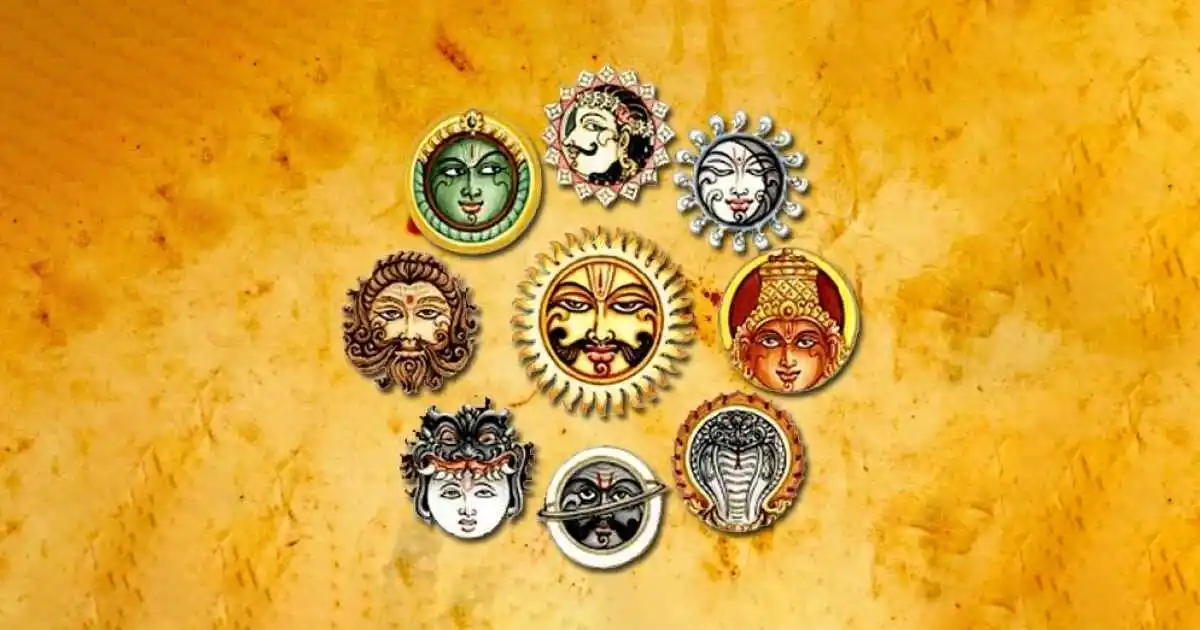 Navagraha, derived from 'Nava' (nine) and 'Graha' (planets), refers to the nine celestial bodies observed in Hindu astronomy. Each of these planets is accorded a divine status in Hinduism. The Navagraha Stotra, an important Hindu hymn, acknowledges the significant role these celestial entities play in our lives. The prestigious Sage Shri Vyasa, a central and revered figure in most Hindu traditions, is attributed as the composer of the Navagraha Stotra. Sage Vyasa's insightful description of these planets provides glimpses of the advancements made in ancient Indian astronomy, demonstrating a considerable understanding of the solar system's construction.
Navagraha, derived from 'Nava' (nine) and 'Graha' (planets), refers to the nine celestial bodies observed in Hindu astronomy. Each of these planets is accorded a divine status in Hinduism. The Navagraha Stotra, an important Hindu hymn, acknowledges the significant role these celestial entities play in our lives. The prestigious Sage Shri Vyasa, a central and revered figure in most Hindu traditions, is attributed as the composer of the Navagraha Stotra. Sage Vyasa's insightful description of these planets provides glimpses of the advancements made in ancient Indian astronomy, demonstrating a considerable understanding of the solar system's construction.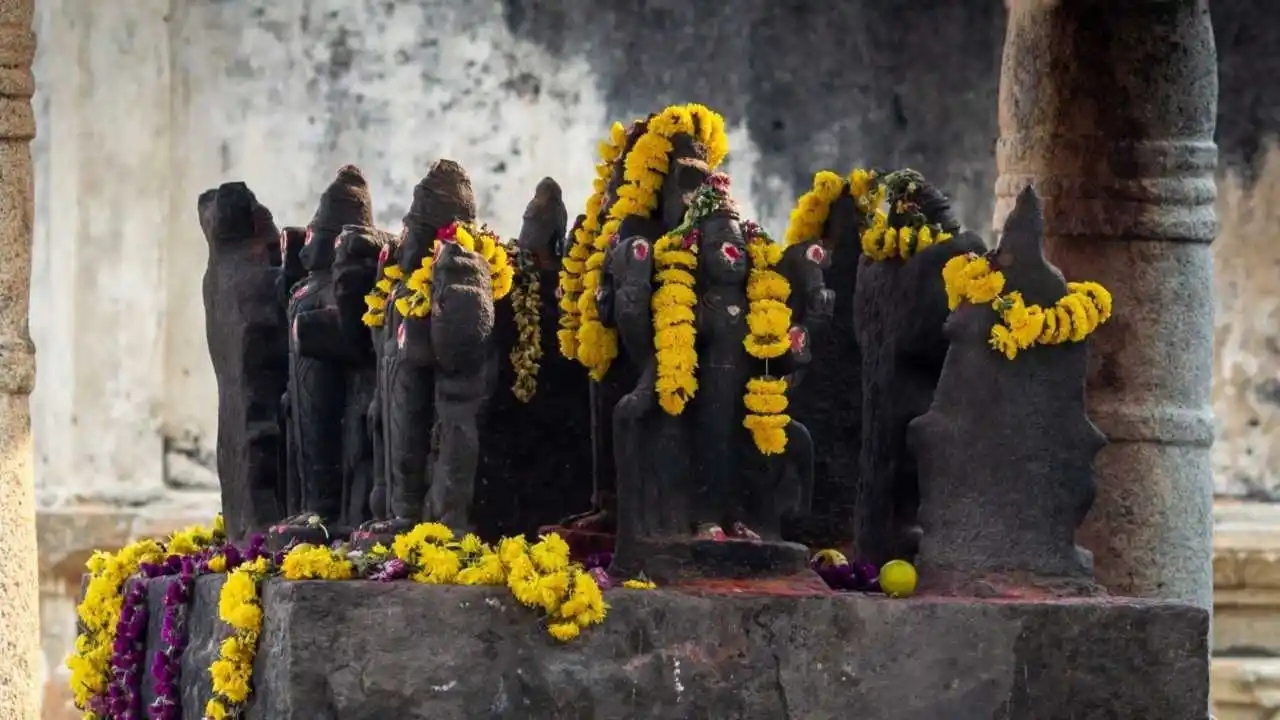

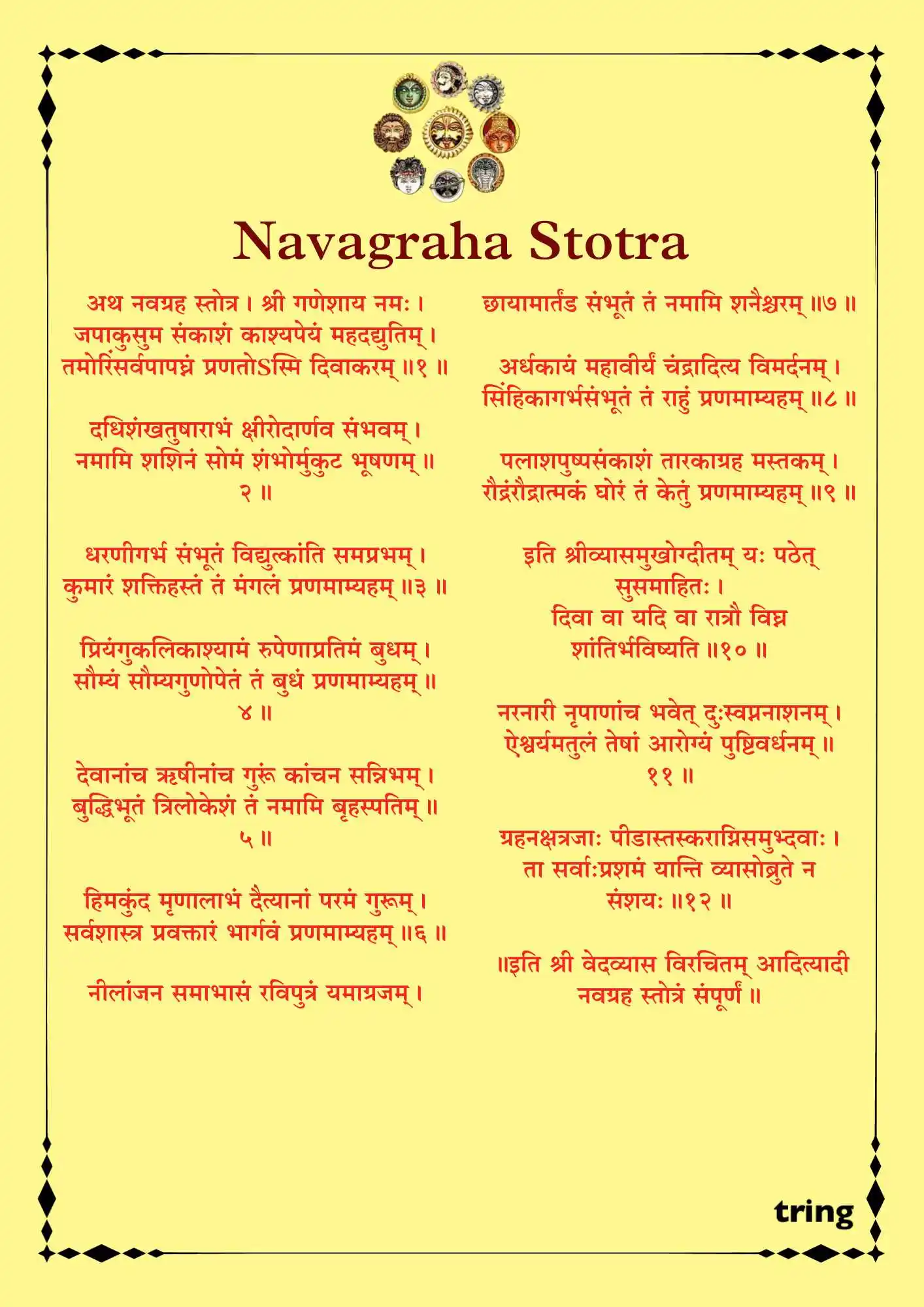
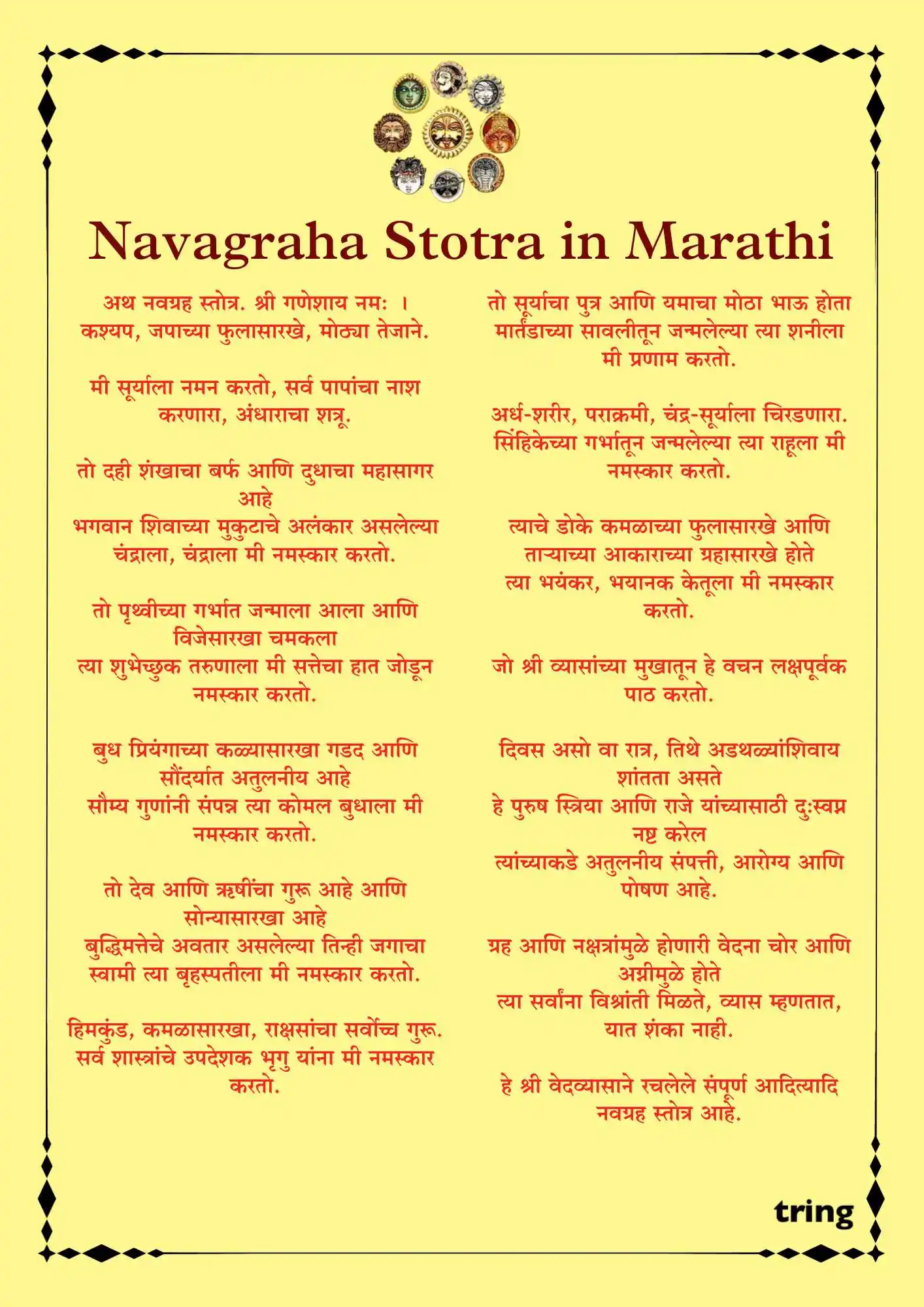

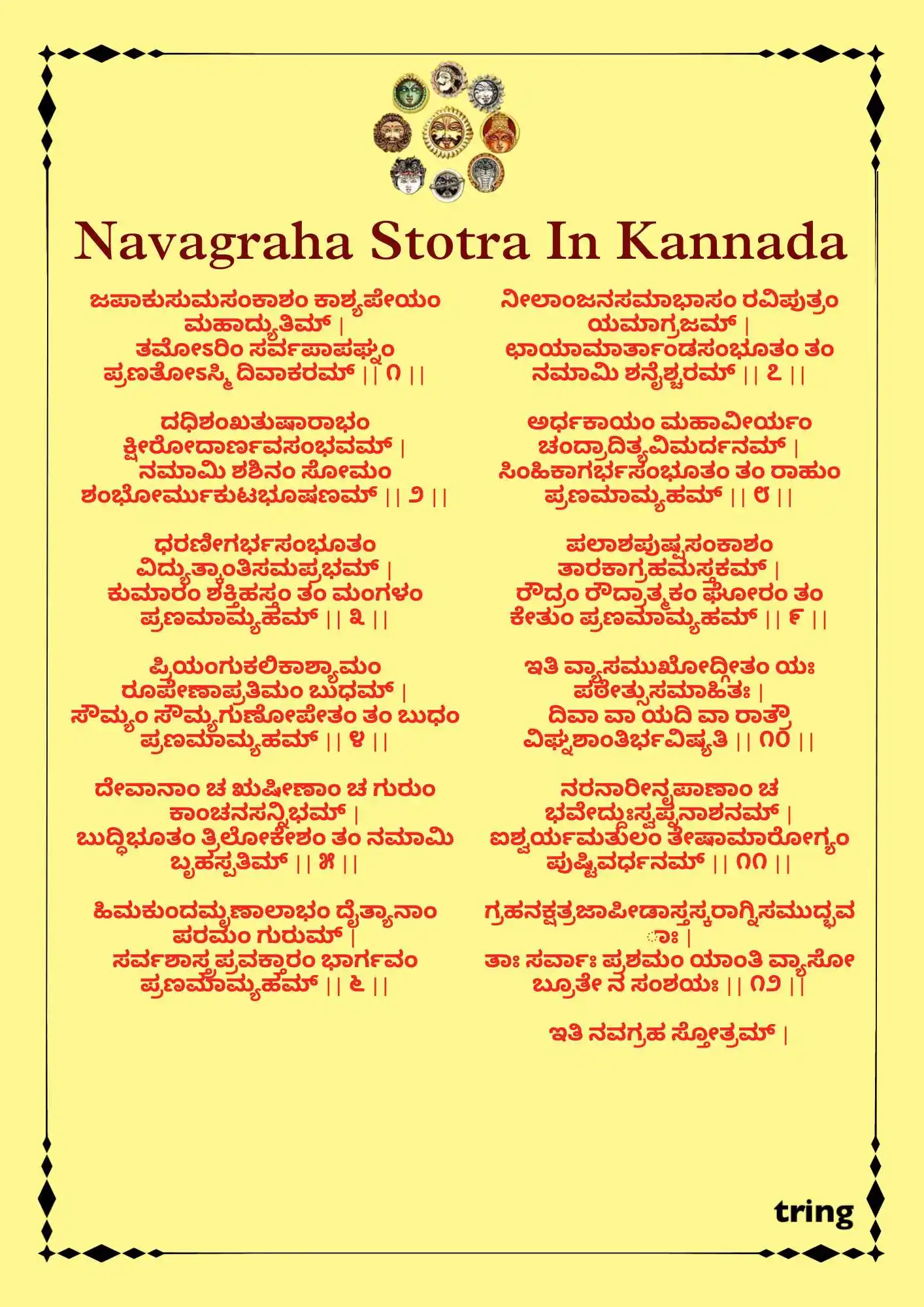








 We now support international payments
We now support international payments
